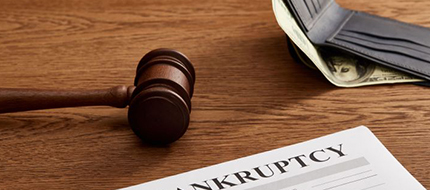Understanding Chapter 13
Since chapter 13 involves financial commitments of the debtor, it Chapter 13 is made for individuals and married couples, who need some debt relief, and who have steady monthly income with which to pay debts under a reorganization plan, although most married couples file chapter 13 together, there is no mandate that they do so. One is not liable for a debt of another, simply on the basis of marriage. Each person owes his or her own debt. However, in most cases the married couple has joint debts by way of them both signing the contract, or promising to guarantee the debt in some fashion. Because a chapter 13 involves a reorganization of financial commitments, it usually involves joining all family debt together to attempt to resolve the debt over load.
In other words the family has "disposable income?. Disposable income is defined as that surplus left after paying normal and basic necessary expenses on a monthly basis. In chapter 13, unlike in chapter 7, there is disposable income that can be used to pay creditors, once the payments to those creditors are reduced in the chapter 13 plan. For example, a family may be struggling to pay all of its debt each month, because of some unforeseen circumstance, such as a temporary loss of employment, or temporary health problems. The problem also may have occurred simply by the fact that the family debt has gotten out of hand. A chapter 13 allows them to catch up back payments on their home mortgage debt, reduce monthly vehicle payments, and reduce unsecured debts by a reduction in monthly payments, and/or a reduction in the balances due. The balance due on a mortgage secured by a family's primary home cannot be reduced as part of a chapter 13 bankruptcy. However, as stated above, a chapter 13 will allow the debtors to "cure? (i.e. catch up) the "arrearage? (i.e. back payments) on the mortgage.
A vast number of chapter 13 cases are filed to stop a foreclosure of the family home. This can be done even if the foreclosure has already begun. The filing of any bankruptcy case immediately invokes an "automatic stay? (i.e. federal injunction) prohibiting the foreclosure suit from going forward. It also prohibits creditor harassment, other law suits, repossessions, wage garnishments, and other creditor action. In fact a creditor is prohibited from contacting the debtor after a bankruptcy case is filed. Being free of creditor actions allows the debtors and their lawyer to fully discuss options, and a plan going forward.
The chapter 13 "plan? is prepared by the debtors' lawyer with the help of the debtors, who answer questions, and provide documentation. This documentation involves the debtors' assets (i.e. property), and the debtors' liabilities (i.e. debts). In any bankruptcy case the lawyer has 60 to 80 pages of paperwork to fill out. This paperwork is called the bankruptcy "schedules.? Besides the schedules, a chapter 13 also includes the preparation of the debtors' repayment plan. Once all the paperwork is filled out and reviewed by the debtors and their lawyer, the lawyer and his or her paralegal electronically file the paperwork with the Bankruptcy Court. Within days thereafter, the Bankruptcy Court mails the official notice of the bankruptcy case with a case number, and instructions to all the creditors that the debtors listed. It is extremely important to list all creditors so that the federal injunction applies to them. After all if a creditor is not listed, it would continue actions against the debtor, due to its not having been made aware of the bankruptcy filing.
In other words the family has "disposable income?. Disposable income is defined as that surplus left after paying normal and basic necessary expenses on a monthly basis. In chapter 13, unlike in chapter 7, there is disposable income that can be used to pay creditors, once the payments to those creditors are reduced in the chapter 13 plan. For example, a family may be struggling to pay all of its debt each month, because of some unforeseen circumstance, such as a temporary loss of employment, or temporary health problems. The problem also may have occurred simply by the fact that the family debt has gotten out of hand. A chapter 13 allows them to catch up back payments on their home mortgage debt, reduce monthly vehicle payments, and reduce unsecured debts by a reduction in monthly payments, and/or a reduction in the balances due. The balance due on a mortgage secured by a family's primary home cannot be reduced as part of a chapter 13 bankruptcy. However, as stated above, a chapter 13 will allow the debtors to "cure? (i.e. catch up) the "arrearage? (i.e. back payments) on the mortgage.
A vast number of chapter 13 cases are filed to stop a foreclosure of the family home. This can be done even if the foreclosure has already begun. The filing of any bankruptcy case immediately invokes an "automatic stay? (i.e. federal injunction) prohibiting the foreclosure suit from going forward. It also prohibits creditor harassment, other law suits, repossessions, wage garnishments, and other creditor action. In fact a creditor is prohibited from contacting the debtor after a bankruptcy case is filed. Being free of creditor actions allows the debtors and their lawyer to fully discuss options, and a plan going forward.
The chapter 13 "plan? is prepared by the debtors' lawyer with the help of the debtors, who answer questions, and provide documentation. This documentation involves the debtors' assets (i.e. property), and the debtors' liabilities (i.e. debts). In any bankruptcy case the lawyer has 60 to 80 pages of paperwork to fill out. This paperwork is called the bankruptcy "schedules.? Besides the schedules, a chapter 13 also includes the preparation of the debtors' repayment plan. Once all the paperwork is filled out and reviewed by the debtors and their lawyer, the lawyer and his or her paralegal electronically file the paperwork with the Bankruptcy Court. Within days thereafter, the Bankruptcy Court mails the official notice of the bankruptcy case with a case number, and instructions to all the creditors that the debtors listed. It is extremely important to list all creditors so that the federal injunction applies to them. After all if a creditor is not listed, it would continue actions against the debtor, due to its not having been made aware of the bankruptcy filing.






